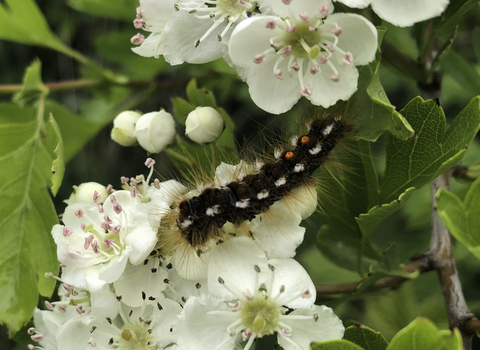
Brown-tail © Nick Upton/2020VISION

Young brown-tail caterpillar © Chris Lawrence

Brown-tail caterpillar © Tom Hibbert
Brown-tail
The caterpillars of this fluffy white moth are best admired from a distance, as their hairs can irritate the skin.
Scientific name
Euproctis chrysorrhoeaWhen to see
Adult: July to August, occasionally also in OctoberCaterpillar: September to May
About
Brown-tail moths are found in coastal habitats and hedgerows and scrubby areas inland, sometimes including parks and gardens. As the name suggests, their most distinctive feature is a dark brown tip to the abdomen. The hairs of the caterpillars cause irritation to human skin, so they shouldn't be touched (they're known as urticating hairs).The strikingly-white adults take to the wing in summer, though there is sometimes a partial second generation of adults that emerges in October. They fly at night when they can be attracted to lights. Females lay clusters of eggs on the caterpillar's foodplant - hawthorn, blackthorn, bramble, sea-buckthorn and other trees and shrubs. They cover the eggs with shed brown hairs from the end of their abdomen.
Once the eggs hatch, the caterpillars create a dense web of silk, covering part of the plant. They live communally inside this web, feeding on leaves. In autumn, the small caterpillars form tougher silk tents where they spend the winter together. They stir again in spring to continue feeding, and can often be seen basking on the outside of the web. Larger caterpillars start to wander before pupating, when they can be found feeding singly on a wider variety of plants. They pupate amongst twigs and leaves, wrapped in a cocoon made from silk and hairs.
What to look for
A rather plain, white moth with a fluffy body and hairy legs. The tip of the abdomen is covered in dark brown hairs, which are more extensive in females. Males have strongly feathered antennae. The yellow-tail moth is very similar, but has yellow hairs on its abdomen, rather than brown.The caterpillars are covered in dense brown hairs. Younger caterpillars are found living in groups in their web, but fully grown caterpillars wander off before pupating. When fully grown, they have two intermittent red lines running in parallel along their back, with two red dots towards the rear. On each side of the red lies is a row of white streaks.
